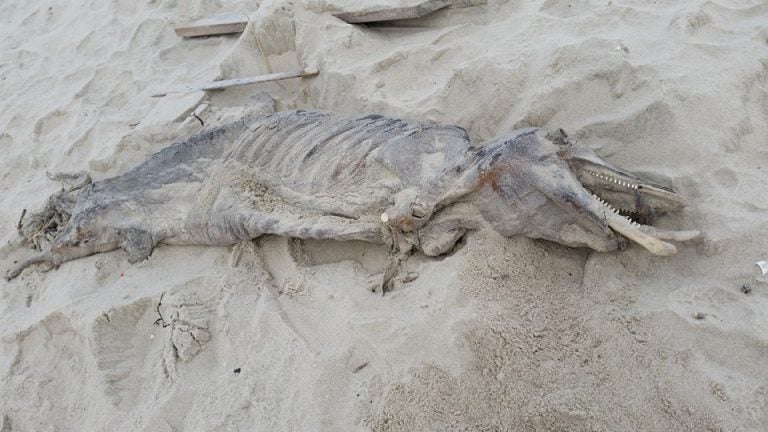Mummified animal discovered on beach after Tuesday’s nor’easter

Denise Wirth stumbled upon the remains of a mummified dolphin while strolling the beach in Lavallette Wednesday. (Photo courtesy of Denise Wirth)
A Barnegat Bay Island resident strolling the beach after Tuesday’s nor’easter discovered the carcass of a “mysterious” creature.
Denise Wirth stumbled upon the remains in Lavallette Wednesday and sent photos of her find to Gregg Sakowicz, a Rutgers University researcher in partnership with the National Estuarine Research Reserve System.
Sakowicz, who pens the popular blog professorsak.com, says that Wirth’s discovery appears to be a common bottlenose dolphin.
But this find is different.
“What is most notable about this individual is, unlike a decayed bloated carcass that has been soaking (and rotting) at sea for some time, this one almost appears mummified,” Sakowicz wrote on his blog.
According to the researcher, the animal may have been buried locally instead of washing ashore.
Sakowicz wrote:
Being a private, non-profit entity with limited resources, if [the Marine Mammal Stranding Center] judges a carcass to be too decayed to determine the cause of death or lack the resources to travel to retrieve it to perform a necroscopy, the remains may be hauled off the beach or buried in place by the local town. If those remains wind up buried in dry, salty sand (which can draw moisture out of the soft tissues as well as starve microbes of oxygen, limiting decay) above the high tide line, a natural (partial) desiccation/mummification process may occur. I have personally witnessed this happen to a large sea turtle years ago while working as a lifeguard, and occasionally seen this effect on once-buried bird carcasses that were exposed by sand-shifting winds.
He says that with significant erosion, which occurred during the nor’easter, “the remains may be unearthed and even transported away from the burial site by wave action and longshore drift.”
However, the discovery remains a mystery.
“I am not sure if it can be determined if this dolphin was buried on-site or came from elsewhere, but either way it is an interesting find that lends itself to questions and conversations,” Sakowicz wrote.
He plans to inspect the remains to see if it yields any additional clues.
WHYY is your source for fact-based, in-depth journalism and information. As a nonprofit organization, we rely on financial support from readers like you. Please give today.

